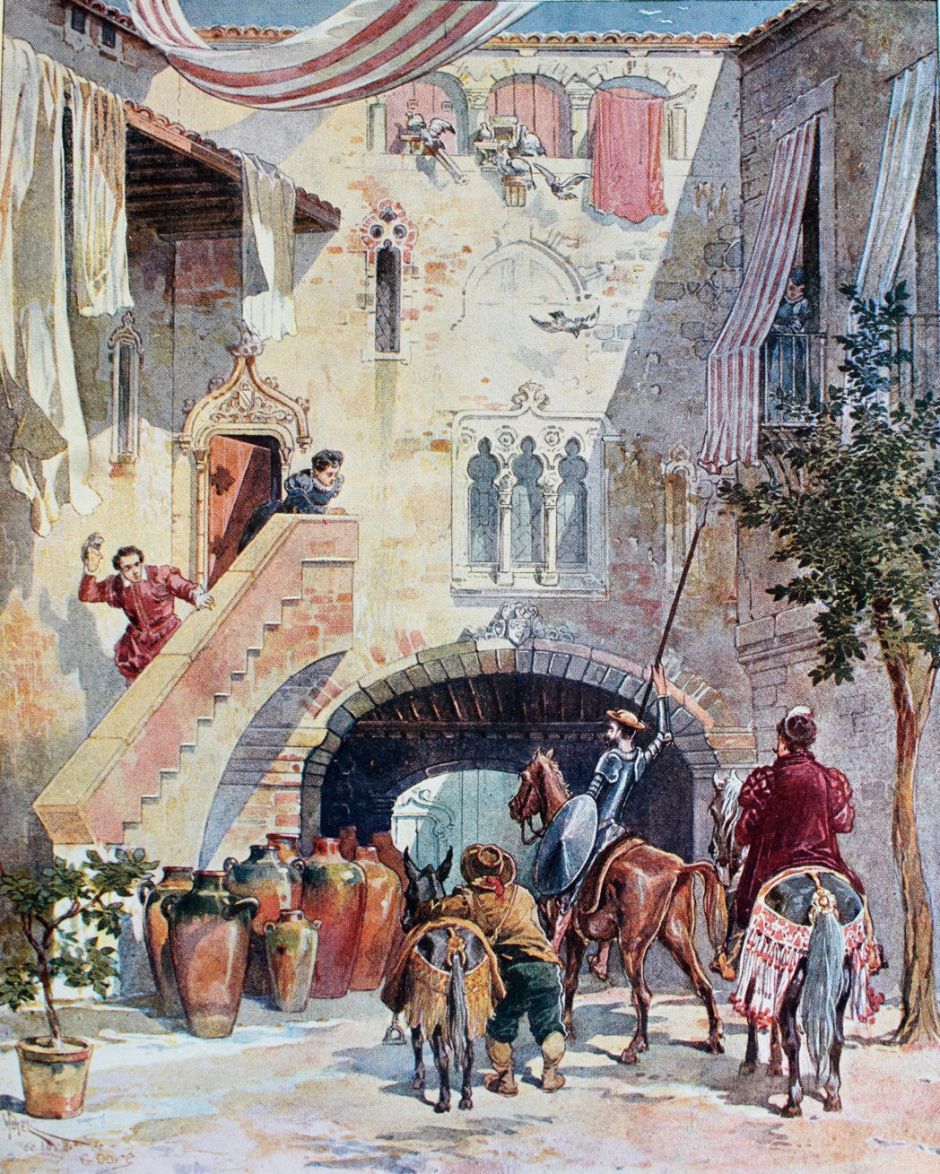In the previous episode, Don Quixote was revelling in his victory in combat over the Knight of the Spangles, unaware that it had all been a set-up to send him back to his village. Meanwhile the defeated young graduate swore vengeance once his injuries had healed. The knight and his squire met another hidalgo, Don Diego, riding back to his village, and were conversing as they came across a cart bearing two lions as a gift to the King. When the knight donned his helmet to deal with this, his face was drenched in the whey from some curds which Sancho Panza had put there temporarily. Don Quixote demanded to confront the lions to show what sort of man he was. With everyone else at a safe distance, one of the crates was opened, but the lion inside it wasn’t interested and lay down without coming out. With the knight’s valour proven, the cart went on its way, and the three travellers arrived in Don Diego’s village by about two o’clock in the afternoon.



When they arrived at Don Diego’s spacious villa, they were greeted by the hidalgo’s wife Doña Cristina and student son Don Lorenzo. The knight was ushered into a room to remove his filthy armour, leaving him in his grimy breeches and doublet. He washed the remains of the whey from his face, and joined Don Lorenzo while the tables were being laid for lunch. Don Diego had warned his son that Don Quixote was mad, but as they spoke, the student of poetry told the knight that he didn’t believe it.
Don Quixote explained to the son about knight errantry, which finally convinced the student of the knight’s madness. They were then called to lunch, following which Don Quixote asked Don Lorenzo to recite his poetry. This brought lavish praise from the knight, who asked for more.

After four days as a guest of Don Diego, Don Quixote thanked the hidalgo for his generous hospitality and begged his leave to proceed to Saragossa, by way of the Cave of Montesinos and the Lakes of Ruidera. When the time came for them to depart, Sancho Panza was dreading to leave the peaceful villa with its abundant meals to return to a life on the road and semi-starvation. They left the hidalgo and his son in wonder at Don Quixote’s mixture of madness and sense.
Soon after leaving the village, Don Quixote and Sancho Panza met four men riding asses. Two were students carrying clothes and a couple of fencing foils, and the others were farmers, also bearing items they had bought from a town. They rode along together, the four listening to the knight give an account of himself, which quickly convinced the students of his madness, and thoroughly confused the farmers. One of the students invited Don Quixote to join them at a lavish wedding, between a rich farmer’s son and the beautiful daughter of another farmer.
This was a perfect match, although the event was expected to be memorable if the bride’s first suitor, a shepherd who lived next door to her, turned up as expected. The bride’s father decided against Basilio the shepherd because of his lack of riches; the groom, Camacho the Rich, was not only far richer, but a fine sportsman and accomplished at fencing. Sancho Panza then revealed that he thought the bride should marry the shepherd, but his master disagreed. The two fell into argument again, and that in turn set the students bickering among themselves about fencing.
The student carrying clothes jumped off his ass and snatched one of the foils being carried by the other, challenging the other to a duel. Don Quixote intervened, insisting on being the umpire of their fencing contest. He dismounted too, and stood in the middle of the road with his lance as the two students came at one another with their foils slashing and lungeing.

The student with the MA easily got the better of the other, cutting his clothes to ribbons and knocking his hat off. The underdog soon fell exhausted, and Sancho Panza suggested that he shouldn’t rush into such fencing duels so unwisely. The two students then embraced one another in strengthened friendship, remounted, and they all rode on to the village together, arriving just as it was getting dark.
The little village had been transformed for the wedding, with lanterns festooned from the trees, and music from many different instruments. But Don Quixote refused to enter, saying that knights errant slept rough in the fields, not in towns. Sancho Panza wasn’t happy with his choice.
That completes the nineteenth chapter of the second book of Don Quixote.
Further reading
Wikipedia
List of characters
English translation by John Ormsby (1885)
Miguel de Cervantes Saavedra, trans John Rutherford (1604, 2000) Don Quixote, Penguin, ISBN 978 0 140 44909 9.
Roberto González Echevarría (2015) Cervantes’ Don Quixote, Yale UP, ISBN 978 0 300 19864 5.
Roberto González Echevarría (ed) (2005) Cervantes’ Don Quixote, A Casebook, Oxford UP, ISBN 978 0 19 516938 6.

